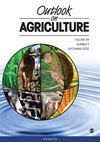Factors affecting farmers’ acceptance and adoption of biofortified crops: A systematic review
IF 2.6
3区 经济学
Q1 AGRICULTURE, MULTIDISCIPLINARY
引用次数: 0
Abstract
Biofortified crops offer a promising solutions to combat micronutrient deficiencies, particularly in developing nations. This study undertakes a systematic review of farmer-level acceptance and adoption of biofortified crops, including the key determinants, methodologies, indicators and measures, and findings related to acceptance and adoption of biofortified crops among farmers. The review identified 24 biofortification studies with farmers conducted across Africa and Asia, primarily in countries such as Nigeria, Uganda, and Tanzania. These studies focus on biofortified crops like rice, banana, cassava, and sweet potato. Notably, a majority of the reviewed studies followed a quantitative approach and employed a cross-sectional design. The key outcome indicators encompassed farmers’ willingness-to-pay, perceptions, beliefs, willingness-to-plant in the next growing season, and the actual adoption itself. These indicators were typically measured using a 5-point Likert scale or a dummy variable. The primary determinants driving farmers to cultivate biofortified crops were classified into four categories: socioeconomic, institutional, agronomic, and psychological and cognitive factors. Given the complex nature of challenges like hidden hunger, an all-encompassing approach is imperative in seeking effective solutions. Understanding the intricate interplay between these factors, which shape the acceptance and adoption of biofortified crops, becomes pivotal in formulating strategies that effectively address this multifaceted issue. To address challenges like hidden hunger, comprehensive solutions are essential. Understanding the factors shaping the adoption of biofortified crops is crucial for effective strategies.影响农民接受和采用生物强化作物的因素:系统综述
生物强化作物为对抗微量营养素缺乏提供了一个很有希望的解决方案,特别是在发展中国家。本研究对农民接受和采用生物强化作物进行了系统回顾,包括关键决定因素、方法、指标和措施,以及与农民接受和采用生物强化作物有关的发现。该综述确定了在非洲和亚洲进行的24项针对农民的生物强化研究,主要是在尼日利亚、乌干达和坦桑尼亚等国家。这些研究的重点是生物强化作物,如水稻、香蕉、木薯和甘薯。值得注意的是,大多数被回顾的研究采用了定量方法并采用了横断面设计。关键结果指标包括农民的支付意愿、看法、信念、在下一个生长季节种植的意愿以及实际采用情况。这些指标通常使用5点李克特量表或虚拟变量进行测量。驱动农民种植生物强化作物的主要决定因素被分为四类:社会经济因素、制度因素、农艺因素以及心理和认知因素。鉴于隐性饥饿等挑战的复杂性,在寻求有效解决办法时必须采取全面的办法。了解这些影响生物强化作物接受和采用的因素之间错综复杂的相互作用,对于制定有效解决这一多方面问题的战略至关重要。要应对隐性饥饿等挑战,全面解决方案至关重要。了解影响采用生物强化作物的因素对于制定有效战略至关重要。
本文章由计算机程序翻译,如有差异,请以英文原文为准。
求助全文
约1分钟内获得全文
求助全文
来源期刊

Outlook on Agriculture
农林科学-农业综合
CiteScore
5.60
自引率
13.30%
发文量
38
审稿时长
>36 weeks
期刊介绍:
Outlook on Agriculture is a peer reviewed journal, published quarterly, which welcomes original research papers, research notes, invited reviews and commentary for an international and interdisciplinary readership. Special attention is paid to agricultural policy, international trade in the agricultural sector, strategic developments in food production, the links between agricultural systems and food security, the role of agriculture in social and economic development, agriculture in developing countries and environmental issues, including natural resources for agriculture and climate impacts.
 求助内容:
求助内容: 应助结果提醒方式:
应助结果提醒方式:


